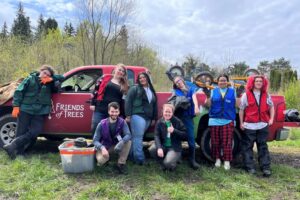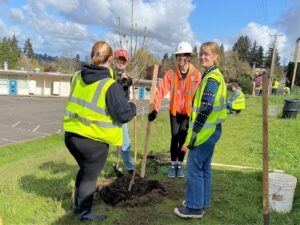Tag: schools
Season Highlights in Eugene-Springfield
Reflecting on another successful season
The Eugene-Springfield team had their final event on May 6th and with hardly a break has already started their summer watering routine. Still, they’ve taken time to reflect on the successes of the 2022- 2023 planting event season. It was a season characterized by more bicycles, new relationships, and emerging leaders.
“We had the most consistent group of new crew leaders this season,” says Eugene-Springfield Program Manager Taylor Glass. “This new cohort quickly rose to lead alongside our veteran CLs. It’s great to have that consistency at planting events.”
The team also worked to expand the use of bicycle crews at planting events. Partnering with PeaceHealth Rides, we had three events with multiple bicycle crews.
“This is something we want to keep doing more of,” says Eugene Director Erik Burke. “Not only is it a sustainability goal, volunteers just really love it.”
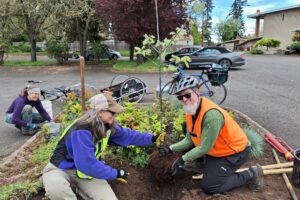
Another area with promising growth this year has been planting at school campuses. We had four plantings at schools, installing trees along the public right of way. The Eugene team has been developing relationships with the school grounds managers to make sure the newly planted trees are well cared for and to find more opportunities to grow tree canopy at school sites.
With the 2023 Greenpower Grant from Eugene Water & Electric Board, the Eugene team looks forward to further expanding its planting program in areas that need trees most. The $50,000 award will fund the expansion of their Neighborhood Tree program to all areas of Eugene with low tree equity scores
Another highlight of the year was especially fun—attending Portland planting events and hosting Portland staff at Eugene events.
“It’s great to spend time together,” Taylor says, “and to exchange ideas on how to do things. Our events are a little different from Portland events.”

One of the things the Eugene team does differently: they keep their neighborhood planting events relatively small. The volunteers largely prefer the more intimate events. They get to connect with each other and still plant plenty of trees.
Thanks to all of this year’s volunteers in Eugene and Springfield!
Opening Doors With Youth Engagement
Our youth programming creates opportunities for young people to engage with nature
Getting youth excited about trees and green spaces is one of the best parts about our work. Friends of Trees engaged over 250 young people through youth programming this season!
“I had kids coming up to me and saying, ‘this is your job?!’” Green Space Specialist Kaitie Benedek says of her time working with students from CF Tigard Elementary School and Fowler Middle School. On five different planting days, 5th, 6th, and 7th grade classes planted native plants at Woodard Park and Dirksen Nature Park, which is adjacent to the middle school’s campus.
“We’d have classes of 25 at a time planting for one class period, so it was super fast,” Kaitie says. “So many kids got excited about planting, and about getting to contribute to this park right by their school. A lot of the kids even named their plants.”
Students from Cascade Education Corps (CEC) helped lead the plantings. CEC members are high school students following an alternative path to graduation by working on hands-on environmental projects. They spend three days per week out in the field working on restoration projects sponsored by other Tree for All partners, including Clean Water Services and Friends of Trees. With elementary, middle and high schoolers working together and people walking by in the park offering encouragement, the plantings at Dirksen and Woodard had a wonderful intergenerational feel to them.
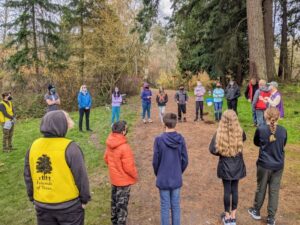
That spirit of connection and mentorship was present at Oregon Trail Elementary too, where forestry students from the Sabin-Schellenberg Center helped facilitate a full day of hands-on environmental education.
“Teachers and parent chaperones were very happy to get the kids outside,” says Green Space Specialist Meng Vue. “These kids weren’t afraid to get dirty.”
Students rotated through five different stations, learning to plant and mulch, decorating wood cookies, and learning about the local ecology with skulls, pelts, and pine cones. The goal was to show students all aspects of a healthy watershed and how planting native plants is an important component of that.
“When you get students involved in learning about the environment, appreciating the place and engaging with it, they’ll take those lessons home and share them,” Meng says.
Harrison Layer, another Green Space Specialist, echoes the importance of opening those doors through education. “When I was young, I saw nature as a big green blob. What are the ways to start to get curious?”
Harrison works closely with students from Portland Opportunities Industrialization Center (POIC), a nonprofit that connects high school youth with career training, including partnering with Friends of Trees. POIC students train as crew leaders and lead Friends of Trees plantings throughout the season.
“We had several students from last year come back this year,” Harrison says, “and it was great to see them grow into a leadership role. The mix of veteran and new students worked really well.”
Working with the POIC crew for an entire season means that you can see amazing growth in skills and confidence. “Everyone grew in their public speaking ability,” Harrison says. “By the end of the season, we had some students who demonstrated the confidence to represent their program through elevator pitches to large groups of volunteers at the beginning of our events.”
In addition to helping at plantings, POIC students got to go on several field trips, including mountain biking at Gateway Green, studying ecosystems at Whitaker Ponds Nature Park, and getting to know turtles and amphibians at Oaks Bottom Wildlife Refuge.
“One of the students at Oaks Bottom referred to this program as ‘unlocking’ new places for them to know and appreciate, much like a video game,” Harrison says. “I loved that!”
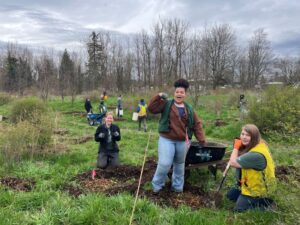
Planting Trees at Eugene Schools
Planting Trees at Charlemagne Elementary School
When you think of an elementary school campus, you probably think of sports fields and playgrounds. And you probably imagine trees—trees for kids to sit in the shade, or hide behind during a game of hide-and-seek, or to collect leaves from for their science classes. But a recent survey in Eugene found that the industrial areas of the city may actually have more canopy than the schools.
To help add trees at our communities’ schools, Friends of Trees did a planting at Charlemagne Elementary School in Southeast Eugene this year. The Eugene team was able to plant 32 street trees in the school’s right-of-way along Potter Street on the east side of the school’s campus. This right-of-way sees a lot of foot traffic from students. Studies show that cars drive more slowly on streets with more trees.
“We’d been hearing that students wanted trees at their school,” says Volunteer & Program Specialist Taylor Glass. “So we scouted out tree locations. The huge right-of-way had a ton of space for us to plant a whole bunch of large trees.”
The wide right-of-way allowed the team to plant trees that will grow into large shade trees, like Ponderosa Pine, Bald Cypress, Oregon White Oak, and Chinkapin Oak. The team made sure to have a mixture of both native and drought tolerant trees, so that the trees will survive and have a lasting impact on the campus. A volunteer from the neighborhood has committed to watering the trees during the first three years, while they get established.
While it’s a bit more complicated to get trees planted on the school grounds, the Eugene team could plant street trees on the right-of-way. Efforts are being made to plant on the school grounds, too.
“This has been one of our largest planting efforts at a school,” says Taylor. “We hope to be able to do more, both on the school grounds here and at other schools that could use more trees.”
Get to know our partner: Chemawa Indian School
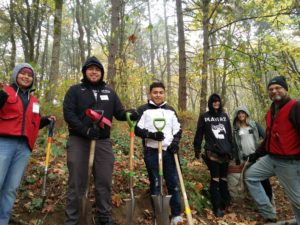
Friends of Trees has been partnering with Chemawa Indian School in Salem for more than five years. Our partnership includes training Chemawa students as Crew Leaders for our planting events in Salem and engaging hundreds of Chemawa students at tree planting and tree care events, including activities at the Chemawa Indian School campus.
This partnership has been driven by dedicated teachers and staff at Chemawa who are passionate about creating opportunities for the students to participate in their community through improving the environment while building their leadership skills.
Chemawa teacher Paula Stuart explains why the partnership is so valuable to Chemawa, “Friends of Trees’ offer to donate trees on Chemawa’s campus has increased awareness of the importance of environmental stewardship. Students who might not have otherwise noticed have joined in, sometimes merely tempted by donuts and hot chocolate, then catching the joy of working outside in teams of happy diggers.”
Paula continues, “Science teachers at the school have offered credit for participation and I am ever so happy that this active engagement has influenced several students’ interest in pursuing environmental careers.”
Finish reading here, where you will find the entire November edition of Treemail, our monthly e-news. Want to catch up on past issues of Treemail? They’re here!
The smiles say everything
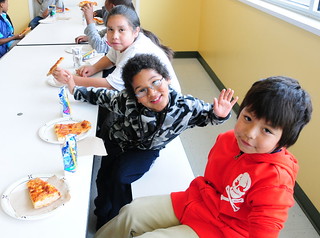
By Gustavo Rojas
Friends of Trees has planted hundreds of thousands of trees in the Portland-Vancouver and Eugene-Springfield areas, and the benefits they bring to our communities are obvious and visible. But sometimes the impact is not as easy to measure, like bringing a smile to a kid who may not always feel like smiling.
We recently participated in a planting with the Community Transitional School, a school for kids whose families are homeless and are experiencing poverty-related challenges. The kids are from five to 14 years old and live in homeless and domestic violence shelters, inexpensive hotels, on the floor of a friend’s home, or outside in their cars. The purpose of the school is to provide them with a stable, supportive environment that promotes both their personal and academic growth.


